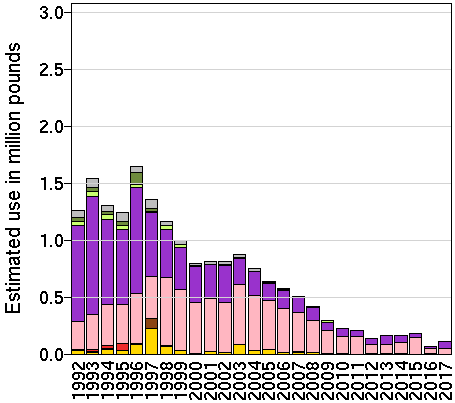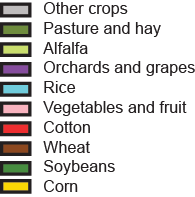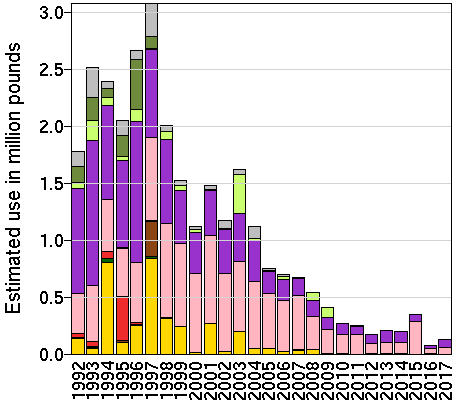Diazinon
dai-a-zuh-naan
High residues found on basil and cilantro. Registered as a U.S. pesticide in 2004. Reregistered in 2006. Currently under registration review.
Overview
Diazinon is used in 14 states.

Diazinon is used in California, Florida, Georgia, Idaho, Indiana, Kentucky, Maryland, Michigan, Oregon, Pennsylvania, South Carolina, Virginia, Washington, and West Virginia.
Data is not available for Alaska, D.C., Hawaiʻi, and U.S. Territories. Data represents the most recent year available from USGS. Details.
See detailed maps of diazinon usage by state and county.
Human Health Effects
Even at low levels of exposure, diazinon can lead to serious negative health effects.
Neurodevelopmental Harm
Reproductive Toxicity
High Risk Exposure Routes
People are exposed to diazinon through food and drinking water, even if they don’t live near areas where pesticides are sprayed. Details.
Food and/or Drinking Water
FarmworkersPeople performing post-application activities in previously treated fields, but do not directly apply pesticides themselves. Details.
Pesticide HandlersPeople involved in pesticide application process. Details.
Residential BystanderPeople who live near areas where pesticides are applied. Details.
Spray Drift
High Residue Foods
Where residue levels of diazinon exceeded allowable limits or were not legally allowed to have residues. Details.
Basil
Cilantro
Percentage of Crops
Diazinon is applied on food widely grown and consumed in the United States.
Lettuce (60%)
Spinach (60%)
Caneberries (50%)
Brussel Sprouts (45%)
Apricots (40%)
Carrots (40%)
Cantaloupes (35%)
Blueberries (25%)
Cabbage (25%)
Onions (25%)
Plums and Prunes (25%)
Registered Uses
Where EPA allows diazinon to be used.
Agricultural Crops: fruit and vegetables, orchards and grapes
Cattle Ear Tags
Additional Information
Estimated Use of Diazinon on Crops
Most recent agricultural crop usage data as provided by the U.S. Geographical Survey’s Pesticide National Synthesis Project. Does not reflect universal usage of diazinon. (How do EPest-low and EPest-high differ?)
U.S. Tolerances Categories & Commodities for Diazinon
The U.S. EPA sets maximum residue limits — known as “tolerances” — on the amount of diazinon that may remain in and on foods. The tolerance is the residue level that triggers enforcement actions.
Tolerances have been set for diazinon for: Agricultural Commodities and Milk Eggs Meat and/or Poultry. Maximum residue limits have been set for diazinon by the U.S. EPA for the following commodities:
Apple
Apricot
Banana
Beans
Blueberry
Carrot
Cattle
Cherry
Cranberry
Cucumber
Endive
Fig
Ginseng
Grape
Hazelnut
Leafy Vegetables
Lettuce
Melon
Mushroom
Nectarine
Onion
Parsley
Parsnip
Peach
Pear
Pepper
Pineapple
Plum
Potato
Radish
Rutabaga
Squash
Strawberry
Sweet Potato
Swiss chard
Tomato
Turnip
Watercress
U.S. EPA Human Health Risk Assessments for Diazinon
Human Health Risk Assessments are conducted by the U.S. EPA to estimate the nature and probability of harmful health effects in people who may be exposed to pesticide. They are used to make informed decisions about approving new pesticides and new uses of registered pesticides, and during our regular review of existing pesticides. Read the assessment for diazinon.


